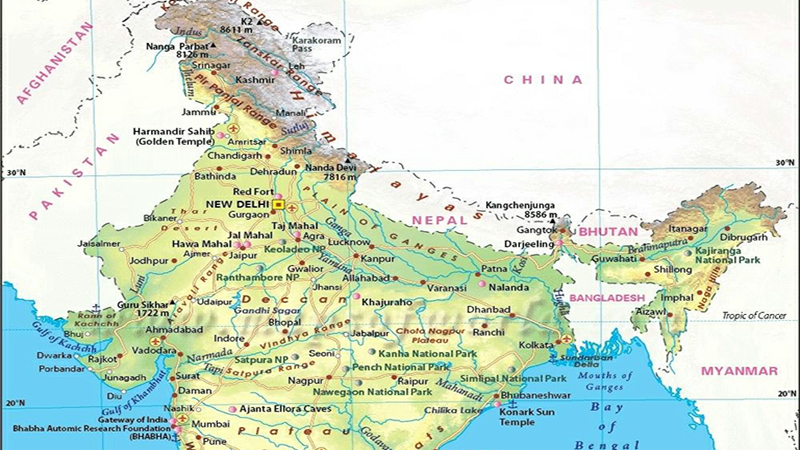Because of India’s hegemonic policies in South Asia,Nepal remains subject to its exploitation as a client state
By Col (R) Muhammad Hanif
Nepal is a Hindu state, which lies along the southern slopes of the Himalayan mountain ranges. It is a landlocked country located between India to the east, south, and west and the Tibet Autonomous Region of China to the north. Its territory extends roughly 500 miles (800 kilometres) from east to west and 90 to 150 miles from north to south.
While Nepal’s border with China comprises of difficult mountainous terrain, its border region with India is easy for transportation since it is a low, flat plain Tarai region, with a 10-mile wide and 500 miles long stretch of fertile agricultural land.
The rest of the country comprises of the rugged and mountainous terrain with varying height ranging from 4000 feet to the Great Himalaya Range, rising to more than 29,000 feet, with the Mount Everest peak being the highest in the world.
In 1991, the kingdom established a multiparty parliamentary system. In 2008, however, after a decade-long period of violence and turbulent negotiations with a strong Maoist insurgency, the monarchy was dissolved, and Nepal was declared a democratic republic. Nepal’s economy is mainly dependent on foreign assistance.
Its main sources of economic assistance have been and are; India, China, the United States, the United Kingdom, Japan, and other smaller rich western nations. The extent of foreign aid to Nepal has been influenced to a considerable degree by the strategic position of the country between India and China.
Due to the geographically landlocked position, and contiguity, Nepal depends on India for trade with the outside world. But because of India’s hegemonic policies in South Asia, Nepal remains subject to its exploitation as a client state. India’s political interference in Nepal through covert and overt means is deep to keep it under control.
Whenever Nepal does not conform to Indian dictate son trade, and it wants to enhance its relations with non-coercive China and other major powers, as a counterweight, on small pretexts, India closes Nepal’s trade route thus compelling it to compromise.
For example, in March 1989, when two trade treaties between India and Nepal were expired, instead of extending the treaties, India closed 15 of the 17 land entry routes to Nepal for more than three weeks, thus putting Nepal under pressure since it relies on India for all of its petroleum and 35 percent of its other imports. And India is also the lifeline to Nepal for imports from other countries.
As some of the western diplomats had commented at that time, the underlying cause for putting a trade embargo was political and not the expiry of the trade treaties. In fact, in 1988 Nepal had decided to purchase military equipment from China.
The Nepalese government had also announced that it was imposing restrictions on Indian residents and business people in Nepal to limit Indian interference. But India, which had treated Nepal as a client state, considered Nepal’s effort to get closer to China as a betrayal. Hence, to punish Nepal, India closed trade routes on the pretext that trade treaties had expired.
Since then, Nepal has been kept under threat of trade closure if it adopts such policies which hurt India’s interest. And, by using its widely spread intelligence resources in Nepal and its Hindu settlers in that country, India also engineers, political and social unrest to destabilise Nepal to keep the government under pressure and pliant.
For instance, in 2015, India incited the Nepalese people of the border region in Nepal to organise protests on various grounds, and it created a good reason for clamping economic embargo on Nepal to disrupt trade for the whole country. Because of that, Nepalese population suffered a lot who had already suffered from a devastating earthquake. Hence, Nepal remains a prime target of India’s political interference and coercive policies to keep the country as a client state.
However, Nepal seeks to ensure its sovereignty by adopting a diversified foreign policy to avoid over dependence on India and it has become even more careful in view of India’s history in the recent past of militarily interfering in the internal affairs of neighbouring states, as was evident from India’s military interventions in Sri Lanka and the Maldives.
Since the Nepalese are the bold and resilient nation, it continues to defy Indian hegemonic policies and pressures in different possible ways. For instance, recently a huge crowd of protesters marched in Kathmandu and all over Nepal even burning effigies of India’s Prime Minister Narendra Modi while vociferously chanting anti-India slogans.
Although the Nepalese people are bravely struggling to get free of the Indian imperialism, to withstand India’s hegemony collectively, it is important that all other South Asian countries should also reinforce Nepal’s sovereignty by strengthening the role of SAARC and welcoming China to become its regular member as a counterbalance to India.
The writer is an ex-army officer and a former Research Fellow of Islamabad Policy Research Institute (IPRI), Islamabad
‘Courtesy Daily Times’.


